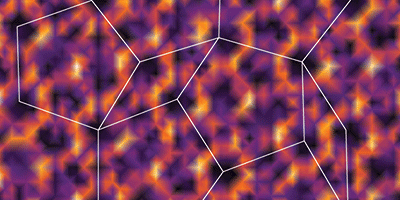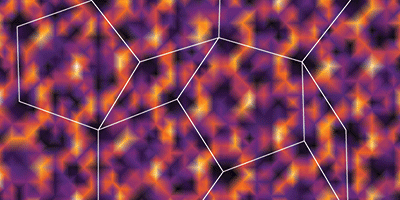A Quantum Quasicrystal
A quasicrystal has an ordered atomic arrangement that never repeats itself. This anomalous structure results in unusual material properties, such as high mechanical strength and poor electrical conduction. But so far, quasicrystalline behavior has not been observed in a quantum system, where the atomic wave functions have a coherent relationship. A group of theorists—writing in Physical Review Letters—explore the possibility of a quantum quasicrystal made from ultracold atoms. Such a system, which is presumably within reach of current experimental techniques, should exhibit excitations not seen in classical quasicrystals.
The first quasicrystals, discovered in the early 1980s, had fivefold symmetry, which implies a pentagonal pattern that does not repeat along any direction (see 7 October 2011 Nobel Focus). Since then, scientists have uncovered many other quasicrystals with a variety of nonrepeating patterns. One unique feature of these aperiodic structures is that they support phononlike excitations called phasons, in which atoms rearrange themselves from one ordered structure to another without altering the energy of the system.
Sarang Gopalakrishnan of Harvard University and colleagues model a quantum quasicrystal formed out of a two-dimensional Bose condensate of cold atoms. Typically the atoms are all in the same ground state, but the researchers assume a laser-induced spin-orbit coupling, which results in multiple ground states that form a circle in momentum phase space. The researchers also assume a strong dipole-dipole interaction, which, in certain cases, causes the atoms to collect in a handful of states that are equally spaced on the momentum circle. This momentum ordering translates into both crystalline and quasicrystalline spatial geometries. The team found that the quantum quasicrystals are unique in that they have more phasons than their classical counterparts. — Michael Schirber





